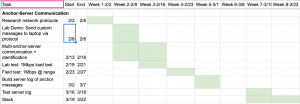This week I confirmed that the design I will first be testing is just using the C calls for oscillators on the Decawave/RaspPi chips.
I found enough other people who were able to use this to enough accuracy for TWR/TDoA communication so it is important for us to give it a try.
I wrote a script in both C and python that calculated nanosecond clock ticks using the monotonic performance counter clock. Now we just need to focus on getting the UWB signals sent and received.
Our split up work is being severely hamstrung by that one component so it makes sense for all of us to work on that one part for now.
Also spent significant time this week reading through decawave documentation to start programming a tag software on the decawave chip. I am approaching the problem with Python while Shiva approaches it with C. We will take whichever one works first and run with it. And worked on the design presentation.
Roadblocks maintain programming the decawave chip (as, begrudgingly, Tamal was 100% right about).



